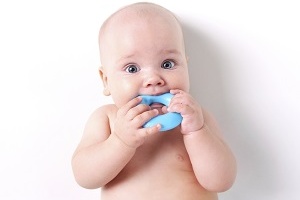Whether it’s to do with breastfeeding, teeth or SIDS, here are some things to consider when deciding whether to give your child a dummy.
Can dummies affect breastfeeding?
Sucking is a powerful reflex that babies have in the weeks after they’re born. Babies don’t just get nutrition from their mother’s milk when they breastfeed – breastfeeding also satisfies their sucking instinct.
Babies who are not able to breastfeed for whatever reason, might satisfy their sucking instincts by using dummies (Cinar, 2003). Yet any substitute for sucking the breast can put the relationship between the breast and the baby at risk. That’s especially true for a baby who has not yet mastered breastfeeding (La Leche League GB, 2019).
When can dummies be used for babies?
Research suggests that it’s best to avoid dummies in the first weeks after birth. That’s because they’re associated with shorter duration of exclusive breastfeeding (Adair, 2003; Kronborg and Vaeth, 2009). Some studies say this is caused by sucking confusion but other studies disagree with this idea (Newman, 1990; Howard et al, 1999).
After breastfeeding is established, dummies can be used. Evidence shows dummies used for healthy babies who are breastfed don’t significantly affect the proportion of babies who exclusively breastfeed at three months (Jaafar et al, 2011). So the use of dummies should be limited to soothing babies after breastfeeding is well established (Adair, 2003; Horne et al, 2014).
Does a dummy reduce the risk of SIDS?
Many studies have suggested dummy use and breastfeeding are important factors for preventing cot death (also known as SIDS [sudden infant death syndrome]) (Hauck et al, 2005; Alm et al, 2016).
It’s unclear how dummies might protect against SIDS or even if they do actually reduce the risk of SIDS at all (Horne et al, 2014; Blair et al, 2019).
Experts do not specifically recommend using dummies to protect babies from SIDS (Fleming et al, 1999). That’s because even studies that reported a remarkable reduction of SIDS with dummy use still say that actually recommending dummies is open to debate (Mitchell et al, 2006). Any association between using dummies and reduced risk of SIDS could be down to lots of other factors, for example:
- Dummies might prevent babies from rolling onto their front.
- Sucking on a dummy may keep babies’ tongues forward.
- A baby that sucks on a dummy might be more still at night, so less likely to become covered by blankets.
- Parents may check on their baby more frequently if their baby has a dummy (Grocock, 2018; Ball, 2019).
What are the advantages of a dummy?
The main advantage of babies having dummies is that they can satisfy their sucking instincts if they’re not breastfed. Using dummies can calm babies and help them to fall asleep (Cinar, 2004). Dummies can also be used to sooth babies at other times, for example to help reduce pain during hospital procedures (Adair, 2003; Horne et al, 2014).
As discussed above, another advantage could be that dummies might protect against SIDS although more evidence is needed (Horne et al, 2014).
What are the disadvantages of using a dummy?
Using dummies can be helpful and convenient but there are some disadvantages. The most important concern is that use of dummies can decrease how often as well as how long babies are breastfed for (Adair 2003; Kronborg and Vaeth 2009; Horne et al 2014).
Another disadvantage of using dummies is that they might also transport bacteria and fungus, which can increase the rate of infections, particularly otitis media - middle ear infection (Uhari et al, 1996; Adair, 2003; Rovers et al, 2008). Mums whose babies used dummies reported more episodes of coughs, wheezing, earache, diarrhoea and gastroenteritis among babies up to six months old (North et al, 1999).
Dummies might also affect how baby teeth grow (Larsson, 1994).
Are dummies bad for baby teeth?
Some studies have found harmful effects on the way teeth grow if dummies are used for a long time (Larsson, 1994). Effects of dummies on baby teeth include overbite, malocclusion, cross bite and open bite (Poyak, 2006).
Using an orthodontic or flat dummy is much better for your baby’s teeth, so that can help. These dummies are much better designed than dummies were in the past (Levrini et al, 2007).
It’s also suggested that parents wean their children off dummies by two years old and discontinue using them before they turn three (Poyak, 2006).
One mum, Helen, says: “My little boy had started sucking his thumb and I thought an orthodontic dummy has got to be better than that because at least one day I can take it away.”
Tips on how and when to stop your baby from using a dummy
If you think using a dummy is affecting breastfeeding (fewer daily feeds, weight gain affected, or difficulties in attaching to the breast) or if you want to wean a younger baby from a dummy, you could try the following:
- If the dummy is being used as a sleep cue, then introducing a different sleep cue can help.
- Give extra attention to your baby by cuddling or nursing instead.
- Try different ways to soothe your baby, such as carrying them in your arms or a sling, or increasing skin-to-skin contact with them. This helps them to feel better.
- You could restrict your baby’s dummy use to certain times only, such as in the car.
- Rewards might work better for an older child – your local children’s centre or health visitor can offer support with this. Some areas even have ’dummy fairies’ at Christmas.
- Try picking a good time to stop using a dummy – when your child is feeling well, things are stable and they’re happy.
- Have a go at hiding the dummy away so your child doesn’t see it.
(Cinhar, 2004; Huffington Post, 2015)
This page was last reviewed in July 2018.
Further information
Our support line offers practical and emotional support with feeding your baby and general enquiries for parents, members and volunteers: 0300 330 0700.
You might find attending one of NCT's New Baby groups helpful as they give you the opportunity to explore different approaches to important parenting issues with a qualified group leader and other new parents in your area.
Make friends with other parents-to-be and new parents in your local area for support and friendship by seeing what NCT activities are happening nearby.
Adair SM. (2003) Pacifier use in children: a review of recent literature. Pediatric Dentistry. 25(5):449-458.
Alm B, Wennergren G, Molborg P, Lagercrantz H. (2016) Breastfeeding and dummy use have a protective effect on sudden infant death syndrome. Acta Pardiatrica. 105: 31-38. Available at: https://www.ncbi.nlm.nih.gov/pmc/articles/PMC5049485/ [Accessed 19th September 2019]
Ball, H. (2019) Dummies, baby sleep info source. University of Durham. Available at: https://www.basisonline.org.uk/hcp-dummies/[Accessed 19 September 2019]
Cinar ND. (2004) The advantages and disadvantages of pacifier use. Contemporary Nurse. 17:1-2, 109-112. https://www.tandfonline.com/doi/abs/10.5172/conu.17.1-2.109 [Accessed 19th September 2019]
La Leche League GB. (2019) Dummies and breastfeeding. Available at: https://www.laleche.org.uk/dummies-and-breastfeeding/ [Accessed 19th September 2019]
Fleming PJ, Blair PS, Pollard K, Platt W, Leach C, Smith I, et al. (1999) Pacifier use and sudden infant death syndrome: results from the CESDI/SUDI case control study. Arch Dis Child. 81(2):112-116. Available at: https://www.ncbi.nlm.nih.gov/pmc/articles/PMC1718026/ [Accessed 19th September 2019]
Grocock R, Robertson C, Brown N. (2018) Dummies: a review of the evidence; Journal of Health Visiting. 6(4). Available at: https://www.magonlinelibrary.com/doi/full/10.12968/johv.2018.6.4.182 [Accessed 19th September 2019]
Hauck FR, Omojokun OO, Siadaty Ms. Do pacifiers reduce the risk of sudden infant death syndrome? A meta-analysis. Paediatrics. 116(5):e716-e723. Available at: https://www.ncbi.nlm.nih.gov/pubmed/16216900 [Accessed 19th September 2019]
Howard CR, Howard FM, Lanphear B, deBlieck EA, Eberly S, Lawrence RA. (1999) The effects of early pacifier use on breastfeeding duration. Pediatrics. 103(3):e33. Available at: https://www.ncbi.nlm.nih.gov/pubmed/10049989 [Accessed 19th September 2019]
Horne RSC, Hauck FR, Moon RY, L’Hoir MP, blair PS. (2014) Dummy (pacifier) use and sudden infant death syndrome: Potential advantages and disadvantages. J Paediatrics Child Health. 50:170-174.
Huffington Post. (2015) 9 Ways to wean your baby off the dummy. Available at: https://www.huffingtonpost.co.uk/2014/08/14/9-ways-to-wean-your-baby-off-the-dummy_n_7336610.html [Accessed 19th September 2019]
Jaafar SH, Jahanfar S, Angolkar M, Ho JJ. (2011) Pacifier use versus no pacifier use in breastfeeding term infants for increasing duration of breastfeeding. Cochrane Database Syst Rev. (3):CD007202. https://www.cochranelibrary.com/cdsr/doi/10.1002/14651858.CD007202.pub2/full [Accessed 19th September 2019]
Kronborg H, Vaeth M. (2009) How are effective breastfeeding technique and pacifier use related to breastfeeding problems and breastfeeding duration. BIRTH. 36:1. Available at: https://onlinelibrary.wiley.com/doi/pdf/10.1111/j.1523-536X.2008.00293.x [Accessed 19th September 2019]
Larsson E. (1994) Artificial sucking habits: etiology, prevalence and effect on occlusion. Int J Orofacial Myology. 20:10-21. Available at: https://www.ncbi.nlm.nih.gov/pubmed/9055659 [Accessed 19th September 2019]
Levrini L, Merlo P, Paracchini L. (2007) Different geometric patterns of pacifiers compared on the basis of finite element analysis. European J Paediatric Dentistry. 8(4):173-178. Available at: https://www.ncbi.nlm.nih.gov/pubmed/18163851 [Accessed 19th September 2019]
Mitchell EA, Blair PS, L’Hoir MP. (2006) Should pacifiers be recommended to prevent sudden infant death syndrome? Pediatrics. 117(5):1755-1758 Available at: https://www.ncbi.nlm.nih.gov/pubmed/16651334 [Accessed 19th September 2019]
Newman J. (1990) Breastfeeding problems associated with the early introduction of bottles and pacifiers. J Hum Lact. 6(2):59-63. Available at: https://www.ncbi.nlm.nih.gov/pubmed/2346601 [Accessed 19th September 2019]
North K, Fleming P, Golding J. (1999) Pacifier use and morbidity in the first six months of life. Pediatrics. 103: E34. Available at: https://www.ncbi.nlm.nih.gov/pubmed/10049990 [Accessed 19th September 2019]
Poyak J. (2006) Effects of pacifiers on early oral development. Int J Orthod Milwaukee. 17(4):13-6. Available at: https://www.ncbi.nlm.nih.gov/pubmed/17256438 [Accessed 19th September 2019]
Rovers MM, Numans ME, Langenbach E, Grobbee DE, Verheij TJ, Schilder AG. (1999) Is pacifier use a risk factor for acute otitis media? A dynamic cohort study. Fam Pract. 2008 Aug;25(4):233-6. Available at: https://www.ncbi.nlm.nih.gov/pubmed/18562333 [Accessed 19th September 2019]
Uhari M, Mantysaari K, Niemela. (1996) A meta-analytic review of the risk factors for acute otitis media. Clin Infect Dis. 22(6): 1079-83. Available at: https://www.ncbi.nlm.nih.gov/pubmed/8783714 [Accessed 19th September 2019]








